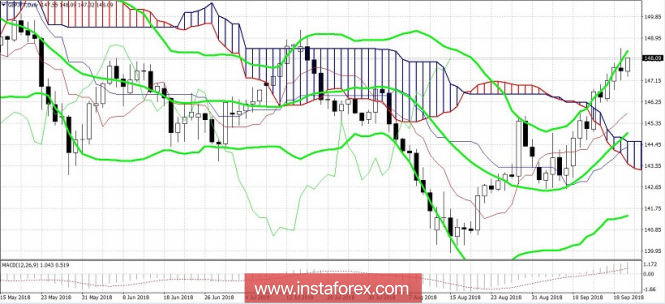The Bank of Japan did not present any surprises at its September meeting, confirming its commitment to its previous course. Haruhiko Kuroda praised the moderate growth of the country's economy, but stressed that the current parameters of monetary policy will operate for a long time.
The yen has completely ignored this fact, and it is justified, since such rhetoric has been voiced for several years. The September meeting was a "pass-through", although some intrigue from the day before was still there. Back in July, the central bank expanded the range of the expected rate, thus allowing the probability of monetary policy easing. Given the weak growth rates of wages and inflation, traders expected to hear hints of a possible reduction in the interest rate to -0.2%. But Kuroda has taken this scenario for the future, while noting positive trends in inflation. He also stated that inflation remained below the target level and that achieving it would require a longer time range than previously anticipated.
This suggests that the Bank of Japan will not consider tightening monetary policy this year and next year, and if inflation slows down, it will resort to easing it. This position also did not have a significant impact on the market – traders got used to the idea that before 2020 it is useless to expect any decisive action from the Japanese regulator. Therefore, making sure that the central bank will not reduce the rate in the near future, traders of the GBP/JPY cross-pair focused on more significant fundamental factors, which are primarily associated with Brexit.
Today, an informal summit of the EU countries is taking place in Salzburg, where the parties will discuss the positions of Brussels and London in the context of a possible deal. This is the first stage of negotiations in an expanded format - an official EU summit will be held in October, and in November a historic agreement should be signed at a special meeting of representatives of the Alliance. But it is the Salzburg summit that plays a key role for Brexit. Against the background of preliminary optimistic statements and comments of the negotiators, the expectations of the market are largely overstated. Traders are waiting for the first individuals to confirm the preliminary agreements, which were hinted by Michel Barnier and Dominique Raab. In particular, we are talking about the issue of the Irish border: according to rumors, Theresa May will reject the proposed Brussels project to resolve this key problem. If these rumors are confirmed, the remaining agreements will lose their meaning, as the parties will have to re-find a common denominator in the most urgent issue.
But there is another side of the coin: if the summit participants are able to form a common position (at least a framework), the probability of concluding a final deal will increase in many ways. According to the latest rumors, Germany and France are determined to reach an agreement and are ready to make concessions to the British. The only question is, what amount of concessions is Theresa May counting on and whether Europe will be able to meet the demands of London. By and large, this is the main intrigue of the summit in Salzburg, so the market is waiting for the comments of the first individuals.
Thus, the dynamics of the cross-pair depends on the results of the Austrian meeting: all other factors will play a secondary role. Here it is worth noting that the yen enjoys the status of a safe haven asset, so when global trade conflicts escalate, it can start "its own game". But the events of recent days have reduced the demand for defensive tools, despite the actions of the White House and Chinese countermeasures. The market actually ignored this exchange of blows of economic nature, as the parties still remained "in the zone of mutual reach" in the context of the planned negotiations. And a recent statement by Donald Trump that the parties "at a certain stage" will still have to conclude a deal, only increased doubts about the further escalation of the trade war. Against this background, the Japanese currency has ceased to be in demand throughout the market, including the pair with the pound.
In summary, it should be noted that the upward trend of the GBP/JPY pair will be continued only if the market sees the prospects of a deal between London and Brussels at the end of the meeting in Salzburg. Otherwise, we expect a significant corrective pullback of the price.

Technically, the GBP/JPY pair continues to be in a pronounced upward trend. This is confirmed by the main trend indicators - Ichimoku Kinko Hyo and Bollinger Bands. Thus, the Ichimoku Kinko Hyo indicator formed the "Parade of lines" signal, and the Bollinger Bands is in the extended channel, while the price is testing its upper line. The nearest correction level is the level of 145.80, which corresponds to the Tenkan-sen line of the Ichimoku Kinko Hyo indicator. And the immediate target of the upward movement is the price of 148.50 - this is the top line of the Bollinger Bands indicator on D1.
The material has been provided by InstaForex Company - www.instaforex.com